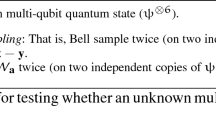Abstract
It is often stated that AND/EXOR circuits are much easier to test than AND/OR circuits. This statement, however, only holds true for circuits derived from restricted classes of AND/EXOR expressions, like positive polarity Reed-Muller and fixed polarity Reed-Muller expressions. For these two classes of expressions, circuits with good deterministic testability properties are known. In this paper we show that these circuits also have good random pattern testability attributes. An input probability distribution is given that yields a short expected test length for biased random patterns. This is the first time theoretical results on random pattern testability are presented for 2-level AND/EXOR circuit realizations of arbitrary Boolean functions. It turns out that analogous results cannot be expected for less restricted classes of 2-level AND/EXOR circuits. We present experiments demonstrating that generally minimized 2-level AND/OR circuits can be tested as easy (or hard) as minimized 2-level AND/EXOR circuits.
Similar content being viewed by others
References
J. Saul, “Logic Synthesis for Arthmetic Circuits Using the Reed-Muller Representation,” In Proc. European Conf. on Design Automation, 1992, pp. 109–113.
A. Sarabi and M.A. Perkowski, “Fast Exact and Quasi-Minimal Minimization of Highly Testable Fixed-Polarity AND/XOR Canonical Networks,” In Proc. Design Automation Conf., pp. 30–35, 1992.
D. Brand and T. Sasao, “Minimization of AND-EXOR Expressions Using Rewrite Rules,” IEEE Trans. on Comp., Vol. 42, pp. 568–576, 1993.
M. Escobar and F. Somenzi, “Synthesis of AND-EXOR Expressions via Satisfyability,” Proc. IFIP WG 10.5 Workshop on Applications of the Reed-Muller Expansion in Circuit Design, 1995, pp. 80–87.
T. Hirayama and Y. Nishitani, “A Simplification Algorithm of AND/EXOR Expressions for Multiple-Output Functions,” Proc. IFIPWG10.5Workshop on Applictions of the Reed-Muller Expansion in Circuit Design, 1995, pp. 88–93.
S.M. Reddy, “Easily Testable Realizations for Logic Functions,” IEEE Trans. on Comp., Vol. 21: pp. 1183–1188, 1972.
J.A. Waicukauski, E. Limbloom, E.B. Eichelberger, and O.P. Forlenza, “A Method for Generating Weighted Random Test Patterns,” IBM J. Res. Develop., Vol. 33, No. 2, pp. 149–161, 1989.
N.A. Touba and E.J. McCluskey, “Automated Logic Synthesis of Random Pattern Testable Circuits,” In Proc. Int Test Conf., 1994, pp. 174–183.
T. Sasao, “Representation of Logic Functions Using EXOR Operators,” Proc. IFIP WG 10.5 Workshop on Applictions of the Reed-Muller Expansion in Circuit Design, 1995, pp. 11–20.
T. Sasao, “AND-EXOR expressions and their optimization,” In T. Sasao, (Ed.), Logic Synthesis and Optimization, Kluwer Academic Publishers, 1993.
I.S. Reed, “AClass of Multiple-Error-Correcting Codes and their Decoding Scheme,” IRE Trans. Inf. Theory, Vol. 3, pp. 6–12, 1954.
M. Davio, J.P. Deschamps, and A. Thayse, Discrete and Switching Functions, McGraw-Hill, 1978.
R.D. Eldred, “Test Routines Based on Symbolic Logical Statements,”Journal of the ACM, Vol. 6, No. 1, pp. 33–36, 1959.
M.A. Breuer and A.D. Friedman, Diagnosis & Reliable Design of Digital Systems. Computer Science Press, 1976.
T. Sasao, “Easily Testable Realizations for Generalized Reed-Muller Expressions,” In Proc. Asian Test Symp., pp. 157–162, 1994.
K.K. Saluja and S.M. Reddy, “Fault Detection Test Sets for Reed-Muller Canonical Networks,” IEEE Trans. Comp.,Vol. 24, pp. 995–998, 1975.
T. Sasao, Logic Synthesis and Optimization, Kluwer Academic Publishers, 1993.
J. Hartmann, The Random Testability of the n-inputANDGate, In Proc. Symp. on Theoreti. Aspects of Comp. Sci. LNCS, Vol. 480, 1991.
A. Sarabi and M.A. Perkowski, “Design for Testability Propertise ofAND/XORNetworks,” Proc. IFIPWG10.5Workshop on Applications of the Reed-Muller Expansion in Circuit Design, Hamburg, 1993, pp. 147–153.
R.L. Graham, D.E. Knuth, and O. Patashnik, Concrete Mathematics, Addision-Wesley, 1988.
R. Drechsler, M. Theobald, and B. Becker, Fast OFDD Based Minimization of Fixed Polarity Reed-Muller Expressions. In Proc. European Design Automation Conf., 1994, pp. 2–7.
R. Drechsler, B. Becker, and N. Göckel, “A Genetic Algorithm for 2-levelAND/EXORMinimization,” In Synthesis and System Integration of Mixed Technologies, pp. 49–56, 1995.
T. Kozlowski, E.L. Dagless, and J.M. Saul, “An Enhanced Algorithm for the Minimization of Exclusive-or Sum-of-Products for Incompletely Specified Functions,” In Proc. Int Conf. on Comp. Design, 1995, pp. 244–249.
R.K. Brayton, G.D. Hachtel, C. McMullen, and A.L. Sangiovanni-Vincentelli, Logic Minimization Algorithms for VLSI Synthesis, Kluwer Academic Publishers, 1984.
Author information
Authors and Affiliations
Rights and permissions
About this article
Cite this article
Drechsler, R., Hengster, H., Schäfer, H. et al. Testability of 2-Level AND/EXOR Circuits. Journal of Electronic Testing 14, 219–225 (1999). https://doi.org/10.1023/A:1008306002882
Issue Date:
DOI: https://doi.org/10.1023/A:1008306002882




